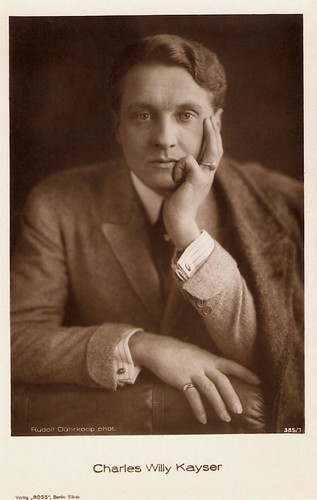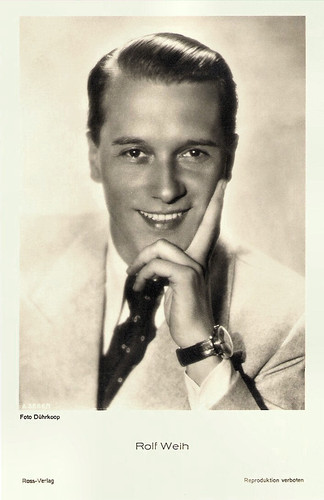Rudolf Dührkoop (1848-1918) was a famous German portrait photographer. He also made artistic photographs in the style of Pictorialism. After his death his studio was taken over by his daughter Minya. In the following decades, the studio portrayed many German film actors. After Minya's death in 1929, the studio kept the name Dührkoop as a brand for quality portrait photography.

Henny Porten. German postcard by Meissner & Buch, Leipzig. Photo: Rud. Dührkoop. A typical Pictorialist photo by Dührkoop. Pictorialism refers to a style in which the photographer has somehow manipulated what would otherwise be a straightforward photograph as a means of 'creating' an image rather than simply recording it. A pictorial photograph appears to lack a sharp focus (some more so than others), is printed in one or more colors other than black-and-white (ranging from warm brown to deep blue) and may have visible brush strokes or other manipulation of the surface.

Paul Heidemann as Teddy. German postcard by Verlag Hermann Leiser, Berlin-Wilm., no. 5233. Photo: R. Dührkoop.

Charles Willy Kaiser. German postcard by Ross Verlag, Berlin, no. 385/1, 1919-1924. Photo: Rudolph Dührkoop Phot.

Werner Fuetterer. German postcard by Ross Verlag, no. 3465/2, 1928-1929. Photo: Atelier Dührkoop, Berlin.

Ruth Weyher. German postcard by Ross Verlag, Berlin, no. 4032/1, 1929-1930. Photo: Atelier Dührkoop, Berlin.
Rudolph Dührkoop was born as the son of a carpenter, Christian Friederich Dührkoop and his wife, Johanna Friederica Emile, in Hamburg in 1848. In 1870 he took part in the Franco-German War. Two years later, he returned home, went into business and married Maria Louise Caroline Matzen, with whom he had two daughters: Hanna Maria Theresia (1872) and Julie Wilhelmine (1873), called Minya.
Dührkoop was interested in photography from the 1870s onwards and gradually acquired the necessary techniques, in particular the collodion process, with limited resources. Collodion, a flammable, syrupy solution of cellulose nitrate in ether and alcohol could be used as an alternative to egg white on glass photographic plates. Collodion reduced the exposure time necessary for making an image.
In 1882, Rudolph Dührkoop published for the first time a photograph in Photographisches Wochenblatt, a Berlin photographic magazine. The following year, he opened a studio in Hamburg and actually became a professional photographer without any training.
Dührkoop started his professional career with making 'Cartes-de-Visite', a kind of business cards with small photos. In addition, he mainly made portrait photographs.
Dührkoop quickly gained success, was often asked to photograph prominent German personalities and in 1886 he became a member of the leading 'Deutschen Photographen-Verein'. Since 1887, Minya worked as an assistant of her father in his studio. From that time they also showed artistic aspirations and in 1898 they held their first exhibition, with a series of portraits by Minya.
From that time on, the fame of the Dührkoops fame rose all over Germany and later internationally. They opened a second studio in Berlin, Rudolph published in leading photo magazines such as Die Kunst in der Photographie and also wrote articles about portrait photography.

Olga Tschechova. German postcard by Ross-Verlag, no. 4033/1, 1929-1930. Photo: Atelier Dührkoop, Berlin. Collection: Didier Hanson.

Hans Stüwe. German postcard by Ross Verlag, no. 4237/1, 1929-1930. Photo: Atelier Dührkoop, Berlin.

Hans Adalbert Schlettow. German postcard by Ross Verlag, no. 4647/1, 1929-1930. Photo: Atelier Dührkoop, Berlin.

Hertha Thiele. German postcard by Ross Verlag, no. 6845/1, 1931-1932. Photo: Gerstenberg-Dührkoop, Berlin.

Camilla Horn. German postcard by Ross Verlag, no. 7916/2, 1932-1933. Photo: Gerstenberg-Dührkoop, Berlin.
In 1904, Rudolf and Minaya Dührkoop took part in the Louisiana Purchase Exposition in Saint Louis, where they came into contact with well-known pictorialist art photographers such as Gertrude Käsebier and George Eastman.
In 1905, Rudolph became the first German member of the prestigious English Royal Photographic Society and in 1906 of the Pictorialist photography association Linked Ring. In addition to his artistic work, Dührkoop always remained active as a portrait photographer and in his career he portrayed a large amount of well-known German personalities.
Minya had worked in the Hamburg studio of her father with growing independence. In 1894, she married the Spanish photographer Luis Diez Vazquez. By 1900 she and father were operating different branches of their Berlin business. The following year she divorced her husband but retained his name Diez in her name.
Father and daughter Dührkoop had a successful business and they took portraits of many notable subjects, including several film actors like Henny Porten and Paul Heidemann. They mixed in artistic circles and they owned a modernist painting by Alma del Banco.
Rudolf Dührkoop died in 1918, 69 years old. After his death his studio was taken over by Minya. One of her contacts was German dancer and actress Lavinia Schulz and her husband Walter Holdt. Schulz's Expressionist costumes were photographed by Diez-Dührkoop. On 18 June 1924, Schulz, in financial ruin, shot Holdt, and then turned the gun on herself. They both died from their wounds.
Minya Diez-Dührkoop died in 1929 in Hamburg. Joachim Gerstenberg became the new owner of Foto-Atelier Dührkoop. In the following years, the studio produced several portraits of German film stars like Hertha Thiele, Camilla Horn and cheeky little Peter Bosse, credited as Atelier Dührkoop, Gerstenberg-Dührkoop or simply Dührkoop. The studio remained active during the war years into the 1950s.

Peter Bosse. German Postcard by Ross Verlag, no. A 1276/1, 1937-1938. Photo: Dührkoop.

Rolf Weih. German postcard by Ross-Verlag, no. A 3586/1, 1941-1944. Photo: Dührkoop.

Sonja Sutter. East-German postcard by VEB Progress Film-Vertrieb, no. 661, 1958. Photo: DEFA / Dührkoop. Publicity still for Lissy (Konrad Wolf, 1957).

Hardy Krüger. German postcard by Ufa, Berlin-Tempelhof, no. FK 3058. Photo: Dührkoop / Ufa.

Sabine Bethmann. German postcard by Ufa, Berlin-Tempelhof, no. FK 4230. Photo: Dührkoop / Ufa.
Sources: Allison Meier (Hyperallergic), Wikipedia (English, German and Dutch)

Henny Porten. German postcard by Meissner & Buch, Leipzig. Photo: Rud. Dührkoop. A typical Pictorialist photo by Dührkoop. Pictorialism refers to a style in which the photographer has somehow manipulated what would otherwise be a straightforward photograph as a means of 'creating' an image rather than simply recording it. A pictorial photograph appears to lack a sharp focus (some more so than others), is printed in one or more colors other than black-and-white (ranging from warm brown to deep blue) and may have visible brush strokes or other manipulation of the surface.

Paul Heidemann as Teddy. German postcard by Verlag Hermann Leiser, Berlin-Wilm., no. 5233. Photo: R. Dührkoop.

Charles Willy Kaiser. German postcard by Ross Verlag, Berlin, no. 385/1, 1919-1924. Photo: Rudolph Dührkoop Phot.

Werner Fuetterer. German postcard by Ross Verlag, no. 3465/2, 1928-1929. Photo: Atelier Dührkoop, Berlin.

Ruth Weyher. German postcard by Ross Verlag, Berlin, no. 4032/1, 1929-1930. Photo: Atelier Dührkoop, Berlin.
Showing artistic aspirations
Rudolph Dührkoop was born as the son of a carpenter, Christian Friederich Dührkoop and his wife, Johanna Friederica Emile, in Hamburg in 1848. In 1870 he took part in the Franco-German War. Two years later, he returned home, went into business and married Maria Louise Caroline Matzen, with whom he had two daughters: Hanna Maria Theresia (1872) and Julie Wilhelmine (1873), called Minya.
Dührkoop was interested in photography from the 1870s onwards and gradually acquired the necessary techniques, in particular the collodion process, with limited resources. Collodion, a flammable, syrupy solution of cellulose nitrate in ether and alcohol could be used as an alternative to egg white on glass photographic plates. Collodion reduced the exposure time necessary for making an image.
In 1882, Rudolph Dührkoop published for the first time a photograph in Photographisches Wochenblatt, a Berlin photographic magazine. The following year, he opened a studio in Hamburg and actually became a professional photographer without any training.
Dührkoop started his professional career with making 'Cartes-de-Visite', a kind of business cards with small photos. In addition, he mainly made portrait photographs.
Dührkoop quickly gained success, was often asked to photograph prominent German personalities and in 1886 he became a member of the leading 'Deutschen Photographen-Verein'. Since 1887, Minya worked as an assistant of her father in his studio. From that time they also showed artistic aspirations and in 1898 they held their first exhibition, with a series of portraits by Minya.
From that time on, the fame of the Dührkoops fame rose all over Germany and later internationally. They opened a second studio in Berlin, Rudolph published in leading photo magazines such as Die Kunst in der Photographie and also wrote articles about portrait photography.

Olga Tschechova. German postcard by Ross-Verlag, no. 4033/1, 1929-1930. Photo: Atelier Dührkoop, Berlin. Collection: Didier Hanson.

Hans Stüwe. German postcard by Ross Verlag, no. 4237/1, 1929-1930. Photo: Atelier Dührkoop, Berlin.

Hans Adalbert Schlettow. German postcard by Ross Verlag, no. 4647/1, 1929-1930. Photo: Atelier Dührkoop, Berlin.

Hertha Thiele. German postcard by Ross Verlag, no. 6845/1, 1931-1932. Photo: Gerstenberg-Dührkoop, Berlin.

Camilla Horn. German postcard by Ross Verlag, no. 7916/2, 1932-1933. Photo: Gerstenberg-Dührkoop, Berlin.
A successful father-daughter business
In 1904, Rudolf and Minaya Dührkoop took part in the Louisiana Purchase Exposition in Saint Louis, where they came into contact with well-known pictorialist art photographers such as Gertrude Käsebier and George Eastman.
In 1905, Rudolph became the first German member of the prestigious English Royal Photographic Society and in 1906 of the Pictorialist photography association Linked Ring. In addition to his artistic work, Dührkoop always remained active as a portrait photographer and in his career he portrayed a large amount of well-known German personalities.
Minya had worked in the Hamburg studio of her father with growing independence. In 1894, she married the Spanish photographer Luis Diez Vazquez. By 1900 she and father were operating different branches of their Berlin business. The following year she divorced her husband but retained his name Diez in her name.
Father and daughter Dührkoop had a successful business and they took portraits of many notable subjects, including several film actors like Henny Porten and Paul Heidemann. They mixed in artistic circles and they owned a modernist painting by Alma del Banco.
Rudolf Dührkoop died in 1918, 69 years old. After his death his studio was taken over by Minya. One of her contacts was German dancer and actress Lavinia Schulz and her husband Walter Holdt. Schulz's Expressionist costumes were photographed by Diez-Dührkoop. On 18 June 1924, Schulz, in financial ruin, shot Holdt, and then turned the gun on herself. They both died from their wounds.
Minya Diez-Dührkoop died in 1929 in Hamburg. Joachim Gerstenberg became the new owner of Foto-Atelier Dührkoop. In the following years, the studio produced several portraits of German film stars like Hertha Thiele, Camilla Horn and cheeky little Peter Bosse, credited as Atelier Dührkoop, Gerstenberg-Dührkoop or simply Dührkoop. The studio remained active during the war years into the 1950s.

Peter Bosse. German Postcard by Ross Verlag, no. A 1276/1, 1937-1938. Photo: Dührkoop.

Rolf Weih. German postcard by Ross-Verlag, no. A 3586/1, 1941-1944. Photo: Dührkoop.

Sonja Sutter. East-German postcard by VEB Progress Film-Vertrieb, no. 661, 1958. Photo: DEFA / Dührkoop. Publicity still for Lissy (Konrad Wolf, 1957).

Hardy Krüger. German postcard by Ufa, Berlin-Tempelhof, no. FK 3058. Photo: Dührkoop / Ufa.

Sabine Bethmann. German postcard by Ufa, Berlin-Tempelhof, no. FK 4230. Photo: Dührkoop / Ufa.
Sources: Allison Meier (Hyperallergic), Wikipedia (English, German and Dutch)
No comments:
Post a Comment